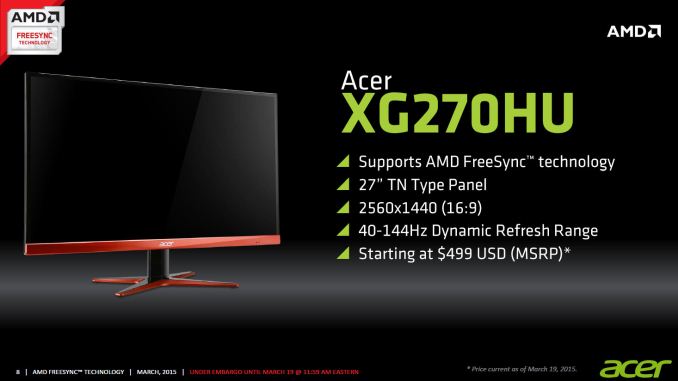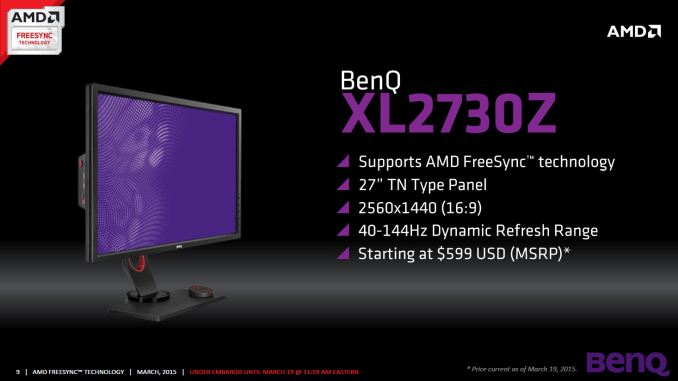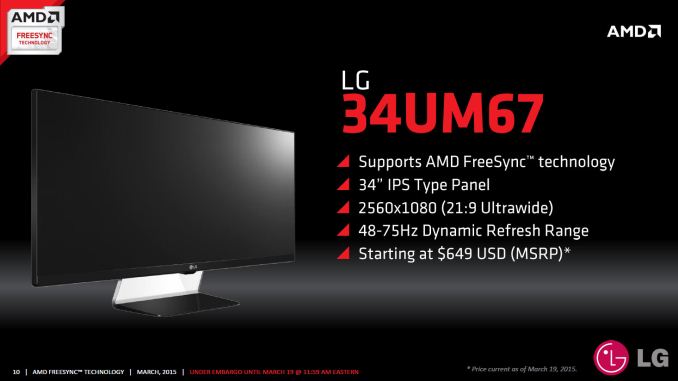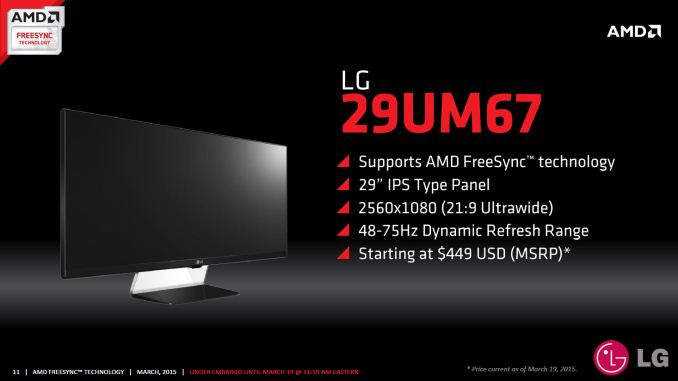The AMD FreeSync Review
by Jarred Walton on March 19, 2015 12:00 PM ESTFreeSync Displays
There are four FreeSync displays launching today, one each from Acer and BenQ, and two from LG. Besides the displays launching today, seven additional displays should show up in the coming weeks (months?). Here’s the current list of FreeSync compatible displays, with pricing where it has been disclosed.
| FreeSync Compatible Displays | ||||||
| Manufacturer | Model | Diagonal | Resolution | Refresh | Panel | Price |
| Acer | XG270HU | 27" | 2560x1440 | 40-144Hz | TN | $499 |
| BenQ | XL2730Z | 27" | 2560x1440 | 40-144Hz | TN | $599 |
| LG Electronics | 34UM67 | 34" | 2560x1080 | 48-75Hz | IPS | $649 |
| LG Electronics | 29UM67 | 29" | 2560x1080 | 48-75Hz | IPS | $449 |
| Nixeus | NX-VUE24 | 24" | 1920x1080 | 144Hz | TN | ? |
| Samsung | UE590 | 28" | 3840x2160 | 60Hz | TN | ? |
| Samsung | UE590 | 23.6" | 3840x2160 | 60Hz | TN | ? |
| Samsung | UE850 | 31.5" | 3840x2160 | 60Hz | TN? | ? |
| Samsung | UE850 | 28" | 3840x2160 | 60Hz | TN? | ? |
| Samsung | UE850 | 23.6" | 3840x2160 | 60Hz | TN? | ? |
| Viewsonic | VX2701mh | 27" | 1920x1080 | 144Hz | TN | ? |
The four displays launching today cover two primary options. For those that want higher refresh rates, Acer and BenQ have TN-based 40-144Hz displays. Both are 27” WQHD displays, so it’s quite probable that they’re using the same panel, perhaps even the same panel that we’ve seen in the ASUS ROG Swift. The two LG displays meanwhile venture out into new territory as far as adaptive refresh rates are concerned. LG has both a smaller 29” and a larger 34” 2560x1080 (UW-UXGA) display, and both sport IPS panels (technically AU Optronics' AHVA, but it's basically the same as IPS).
The other upcoming displays all appear to be using TN panels, though it's possible Samsung might offer PLS. The UE590 appears to be TN for certain, with 170/160 degree viewing angles according to DigitalTrends. The UE850 on the other hand is targeted more at imaging professionals, so PLS might be present; we'll update if we can get any confirmation of panel type.
One of the big benefits with FreeSync is going to be support for multiple video inputs – the G-SYNC displays so far are all limited to a single DisplayPort connection. The LG displays come with DisplayPort, HDMI, and DVI-D inputs (along with audio in/out), and the Acer is similarly equipped. Neither one has any USB ports, though the BenQ does have a built-in USB hub with ports on the side.
Our testing was conducted on the 34UM67, and let me just say that it’s quite the sight sitting on my desk. I’ve been bouncing between the ASUS ROG Swift and Acer XB280HK for the past several months, and both displays have their pros and cons. I like the high resolution of the Acer at times, but I have to admit that my aging eyes often struggle when running it at 4K and I have to resort to DPI scaling (which introduces other problems). The ASUS on the other hand is great with its high refresh rates, and the resolution is more readable without scaling. The big problem with both displays is that they’re TN panels, and having come from using a 30” IPS display for the past eight years that’s a pretty painful compromise.
Plopping the relatively gigantic 34UM67 on my desk is in many ways like seeing a good friend again after a long hiatus. “Dear IPS (AHVA), I’ve missed having you on my desktop. Please don’t leave me again!” For the old and decrepit folks like me, dropping to 2560x1080 on a 34” display also means reading text at 100% zoom is not a problem. But when you’re only a couple feet away, the relatively low DPI does make the pixels much more visible to the naked eye. It even has built-in speakers (though they’re not going to compete with any standalone speakers in terms of audio quality).
The launch price of $649 is pretty impressive; we’ve looked at a few other 21:9 displays in the past, and while the resolution doesn’t match LG’s 34UM95, the price is actually $50 less than the LG 34UM65’s original $699 MSRP (though it’s now being sold at $599). So at most, it looks like putting in the new technology to make a FreeSync display costs $50, and probably less than that. Anyway, we’ll have a full review of the LG 34UM67 in the coming weeks, but for now let’s return to the FreeSync discussion.
Pricing vs. G-SYNC
It certainly appears that AMD and their partners are serious about pricing FreeSync aggressively, though there aren’t direct comparisons available for some of the models. The least expensive FreeSync displays start at just $449, which matches the least expensive G-SYNC display (AOC G2460PG) on price but with generally better specs (29” 2560x1080 and IPS at 75Hz vs. 24” 1920x1080 TN at 144Hz). Looking at direct comparisons, the Acer XG270HU and BenQ XL2730Z are WQHD 144Hz panels, which pits them against the $759 ASUS ROG Swift that we recently reviewed, giving FreeSync a $160 to $260 advantage. As AMD puts it, that’s almost enough for another GPU (depending on which Radeon you’re using, of course).
Based on pricing alone, FreeSync looks poised to give G-SYNC some much needed competition. And it’s not just about the price, as there are other advantages to FreeSync that we’ll cover more on the next page. But for a moment let’s focus just on the AMD FreeSync vs. NVIDIA G-SYNC ecosystems.
Right now NVIDIA enjoys a performance advantage over AMD in terms of GPUs, and along with that they currently carry a price premium, particularly at the high end. While the R9 290X and GTX 970 are pretty evenly matched, the GTX 980 tends to lead by a decent amount in most games. Any users willing to spend $200 extra per GPU to buy a GTX 980 instead of an R9 290X might also be willing to pay $200 more for a G-SYNC compatible display. After all, it’s the only game in town for NVIDIA users right now.
AMD and other companies can support FreeSync, but until – unless! – NVIDIA supports the standard, users will be forced to choose between AMD + FreeSync or NVIDIA + G-SYNC. That’s unfortunate for any users that routinely switch between AMD and NVIDIA GPUs, though the number of people outside of hardware reviewers that regularly go back and forth is miniscule. Ideally we’d see one standard win out and the other fade away (i.e. Betamax, HD-DVD, etc.), but with a one year lead and plenty of money invested it’s unlikely NVIDIA will abandon G-SYNC any time soon.
Prices meanwhile are bound to change, as up to now there has been no competition for NVIDIA’s G-SYNC monitors. With FreeSync finally available, we expect prices for G-SYNC displays will start to come down, and in fact we’re already seeing $40-$125 off the original MSRP for most of the G-SYNC displays. Will that be enough to keep NVIDIA’s proprietary G-SYNC technology viable? Most likely, as both FreeSync and G-SYNC are gamer focused more than anything; if a gamer prefers NVIDIA, FreeSync isn’t likely to get them to switch sides. But if you don’t have any GPU preference, you’re in the market for a new gaming PC, and you’re planning on buying a new monitor to go with it, R9 290X + FreeSync could save a couple hundred dollars compared to GTX 970 + G-SYNC.
There's something else to consider with the above list of monitors as well: four currently shipping FreeSync displays exist on the official day of launch, and Samsung alone has five more FreeSync displays scheduled for release in the near future. Eleven FreeSync displays in the near term might not seem like a huge deal, but compare that with G-SYNC: even with a one year lead (more or less), NVIDIA currently only lists six displays with G-SYNC support, and the upcoming Acer XB270HU makes for seven. AMD also claims there will be 20 FreeSync compatible displays shipping by the end of the year. In terms of numbers, then, DP Adaptive Sync (and by extension FreeSync) look to be winning this war.


























350 Comments
View All Comments
silverblue - Saturday, March 21, 2015 - link
I can certainly let you off most of those, but third party activities shouldn't count, so you can subtract 6 and 12. Additionally, 13 can be picked apart as the 295X2 showed that AMD can present a high quality cooler, and because I believe lumping the aesthetic qualities of a cooler in with heat and noise is a partial falsehood (admit it - you WILL have been thinking of metal versus plastic shrouds). I also don't agree with you on 11; at least, not if you move back past the 2XX generation as AMD had more aggressive bundles back then. 8 is subjective but NVIDIA usually gets the nod here.Also, some of your earlier items are proprietary tech, to which I could always tease you about as it's not as if they couldn't license any of this out. ;)
I'll hand it to you and credit you with your dozen.
chizow - Saturday, March 21, 2015 - link
And I thank you for not doing the typical dismissive approach of "Oh I don't care about those features" that some on these forums might respond with.I would still disagree on 6 and 12 though, ultimately they are still a part of Nvidia's ecosystem and end-user experience, and in many cases, Nvidia affords them the tools and support to enable and offer these value-add features. 3rd party tools for example, they specifically take advantage of Nvidia's NVAPI to access hardware features via driver and Nvidia's very transparent XML settings to manipulate AA/SLI profile data. Similarly, every feature EVGA offers to end users has to be worth their effort and backed by Nvidia to make business sense for them.
And 13, I would absolutely disagree on that one. I mean we see the culmination of Nvidia's cooling technology, the Titan NVTTM cooler, which is awesome. Having to resort to a triple slot water cooled solution for a high-end graphics card is terrible precedent imo and a huge barrier to entry for many, as you need additional case mounting and clearance which could be a problem if you already have a CPU CLC as many do. But that's just my opinion.
AMD did make a good effort with their Gaming Evolved bundles and certainly offered better than Nvidia for a brief period, but its pretty clear their marketing dollars dried up around the same time they cut that BF4 Mantle deal and their current financial situation hasn't allowed them to offer anything compelling since. But I stand by that bulletpoint, Nvidia typically offers the more relevant and attractive game bundle at any given time.
One last point in favor of Nvidia, is Optimus. I don't use it at home as I have no interest in "gaming" laptops, but it is a huge benefit there. We do have them on powerful laptops at work however, and the ability to "elevate" an application to the Nvidia dGPU on command is a huge benefit there as well.
anubis44 - Tuesday, March 24, 2015 - link
@chizow:But hey kids, remember, after reading this 16 point PowerPoint presentation where he points out the superiority of nVidia using detailed arguments like "G-Sync" and "GRID" as strengths, chizow DOES NOT WORK FOR nVidia! He is not sitting in the marketing department in Santa Clara, California, with a group of other marketing mandarins running around, grabbing factoids for him to type in as responses to chat forums. No way!
Repeat after me, 'chizow does NOT work for nVidia.' He's just an ordinary, everyday psychopath who spends 18 hours a day at keyboard responding to every single criticism of nVidia, no matter how trivial. But he does NOT work for nVidia! Perish the thought! He just does it out of his undying love for the green goblin.
chizow - Tuesday, March 24, 2015 - link
But hey remember AMD fantards, there's no reason that the overwhelming majority of the market prefers Nvidia, those 16 things I listed don't actually mean anything if you prefer subpar product and don't demand better, and you continually choose to ignore the obvious one product supports more features and the other doesn't. But hey, just keep accepting subpar products and listen to AMD fanboys like anubis44, don't give in to the reality the rest of us all accept as fact.sr1030nx - Saturday, March 21, 2015 - link
Only if they were NVIDIA branded speaker cables 😉Darkito - Friday, March 20, 2015 - link
FalseDarkito - Friday, March 20, 2015 - link
False, it's indistinguishable "Within the supported refresh rate range" as per this review. What happens outside the VRR window however, and especially under it, is incredibly different. With G-sync, if you get 20 fps it'll actually duplicate frames and tune the monitor to 40Hz, which means smooth gaming at sub-30Hz refresh rates (well, as smooth as 20fps can be). With FreeSync, it'll just fall back to v-sync on or off, with all the stuttering or tearing that involves. That means that if your game ever falls below the VRR window on FreeSync, image quality falls apart dramatically. And according to PCPer, this isn't just something AMD can fix with a driver update because it requires the frame buffer and logic on the G-Sync module!http://www.pcper.com/reviews/Displays/AMD-FreeSync...
Take note that the LG panel tested actually has a VRR window lower bound of 48Hz, so image quality starts falling apart if you dip below 48fps, which is clearly unacceptable.
AdamW0611 - Sunday, March 22, 2015 - link
Yah just like R.I.P Direct X, Mantle will rule the day, now AMD is telling developers to ignore Mantle, Gsync is great, and for those of us who prefer drivers being updated the same day games are released will stick with Nvidia, while months later AMD users will be crying that games still don't work right for them.anubis44 - Tuesday, March 24, 2015 - link
Company of Heroes 2 worked like shit for nVidia users for months after release, while my Radeon 7950 was pulling more FPS than a Titan card. To this day, Radeons pull better, and smoother FPS than equivalently priced nVidia cards in this, my favourite game. The GTX970 is still behind the R9 290 today. Is that the 'same day' nVidia driver support you're referring to?chizow - Tuesday, March 24, 2015 - link
More BS from one of the biggest AMD fanboys on the planet, an AMD *CPU* fanboy nonetheless. CoH2 ran faster on Nvidia hardware from Day1, and also runs much faster on Intel CPUs, so yeah, as usual, you're running the slower hardware in your favorite game simply bc you're a huge AMD fanboy.http://www.techspot.com/review/689-company-of-hero...
http://www.anandtech.com/show/8526/nvidia-geforce-...